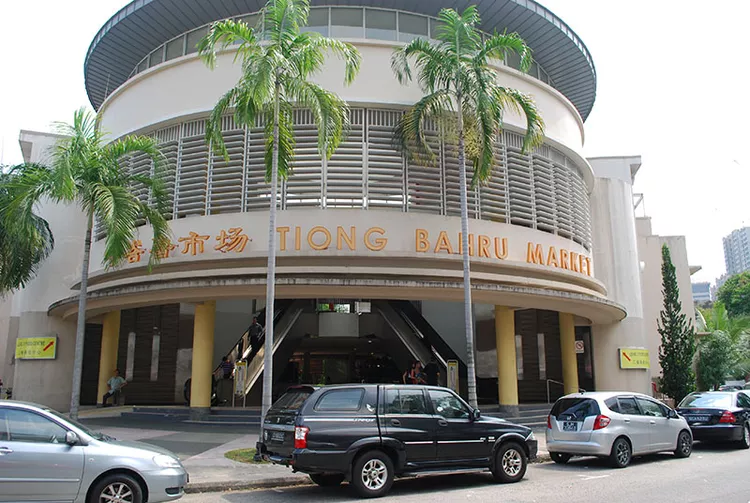Summary
The neighborhood around Tiong Bahru Food Market & Hawker Centre feels unlike the rest of Singapore, in that the past has managed to cling to existence while the rest of the island has been swept away by change.
The name “Tiong Bahru” translates to “New Cemetery”, as the neighborhood had a fair share of graveyards (and squatter settlements) until the Singapore government stepped in to clean up. The Singapore Improvement Trust developed the local public housing, about 50-plus apartments and shophouses built in the Art Moderne style popular in the 1930s.
The curvy apartment buildings look nothing like the government’s later housing blocks, Tiong Bahru’s units having plenty of circles and curves where today’s “HDB blocks” have only square slabs of concrete. The Tiong Bahru Hawker Centre building actually dates back only to 2004, but the designers wisely bucked the temptation to go modern, following the retro design sensibilities of the neighborhood instead.
1. History of Tiong Bahru Hawker Centre
The Tiong Bahru Market that now stands in the center of the neighborhood is, in fact, Singapore’s first modern neighborhood market. Known back in the day as Seng Poh Market (named for the road on which it stood), the market was a solution to the semi-legal street hawker problem that plagued Singapore’s streets at the time.
After years of constant harassment by authorities, the Seng Poh street hawkers asked for a market under which they could trade in peace; the Seng Poh market (completed in 1950) gave them, finally, a permanent place to sell their wares.
“Originally, it was a one-story market,” explains Tan Huay Koon, an assistant director of the National Environment Agency in charge of supervising hawker centers in Singapore. “The [Seng Poh] Market stood for 50 years until the government started the hawker center upgrading program in 2001 – this center was selected for upgrading in 2004.”
2. Tiong Bahru Hawker Centre’s Much Needed Upgrade
The upgrade called for the former Seng Poh Market to be combined with two smaller, neighboring markets and a block of shophouses. After two years’ work and an expenditure of SGD 16 million, the new Tiong Bahru Food Market & Hawker Centre reopened in 2006: a three-storey structure housing a wet market on the first floor and a hawker center on the second, the latter having room for 1,400 diners at any given time.
“Right now, we have 83 cooked food stalls, and 259 market stalls – the fourth largest hawker center in Singapore,” Mr. Tan informs us. “Many of the hawkers here, about twenty stalls, originate from the old Seng Poh market – they were here since the 1950s.”
A look around the stalls bears this out: old favorites like Hong Heng Fried Sotong Prawn Mee (stall 02-01) and Tiong Bahru Mian Jian Kueh (stall 02-34) have been around since the days before Seng Poh Market; the forebears of these stalls’ owners owned itinerant carts or stalls hawking food around Tiong Bahru’s streets until Seng Poh Market was constructed.
Like many hawkers, the business has moved on down the generations – Hong Heng, in particular, is managed by the third generation, the present owner having inherited the stall from his mother, who in turn got it from her brother and her father respectively.
3. Tiong Bahru Hawker Centre’s Food
We arrive to try one of Tiong Bahru Food Market & Hawker Centre’s most famous foods, a steamed rice cake called chwee kueh. The New York Times’ R.W. “Johnny” Apple gave Jian Bo Shui Kueh (stall 02-05) his approval when he ate here with Makansutra’s K.F. Seetoh – “I had no complaints about humdrum flavor when I bit into Jian Bo’s famous chwee kueh,” wrote Apple. “The radishes taste slightly of bitter chocolate, and the chili provides a welcome bit of bite.”
The stall continues to be managed by its first owners, the sisters Tan, whose chwee kueh enjoyed unrivaled popularity even back in the old Seng Poh Market days. Only the sisters Tan know exactly what goes into the stewed, fermented chye poh: sesame seeds, daikon, and other secret ingredients come together into a heavenly topping for plain rice cakes, creating a combination that alternately sears and seduces your taste buds.
“It looks like nothing, [rice cakes topped] with spicy, chopped, stewed daikon,” K.F. Seetoh tells us. “This is the most famous stall, Makansutra gave them a ‘die die must try’ rating.” And so they did: Jian Bo Shui Kueh proudly displays their Makansutra certificate right on their stall’s glass window.
4. Exploring the Tiong Bahru Neighborhood
After eating your fill at the hawker center, leave some room in your schedule to explore the rest of the neighborhood. Strangely for a district so close to Orchard Road and Chinatown, Tiong Bahru has a small-neighborhood feel that endears it to conservationists and heritage junkies.
The shophouses in the neighborhood help make Tiong Bahru “the hippest place in Singapore,” as Seetoh calls it. Brad of the food blog “ladyironchef” writes a guide to Tiong Bahru that covers the venerable neighborhood’s hipster side – its indie bookstores, its artisanal bakeshops, and coffee shops.
For a more structured tour of the neighborhood, join a guided tour conducted under the auspices of Singapore’s National Heritage Board. Volunteer guides from Tiong Bahru residents will take visitors around the Art Moderne apartment blocks to unearth hidden graves, temples, even an authentic pre-war bomb shelter.
How to get there: Tiong Bahru is located about 0.8 miles west of Chinatown and 1.2 miles south of Orchard Road. The closest MRT station is Tiong Bahru Station, about 550 yards west of Tiong Bahru Market. Tiong Bahru Market on Google Maps.
If a fifteen-minute walk doesn’t work for you, go to gothere.sg and input points A and B in plain English (for example, “Raffles Hotel to Tiong Bahru Market”). The site will create a customized itinerary for you that incorporates travel on both bus and MRT.




